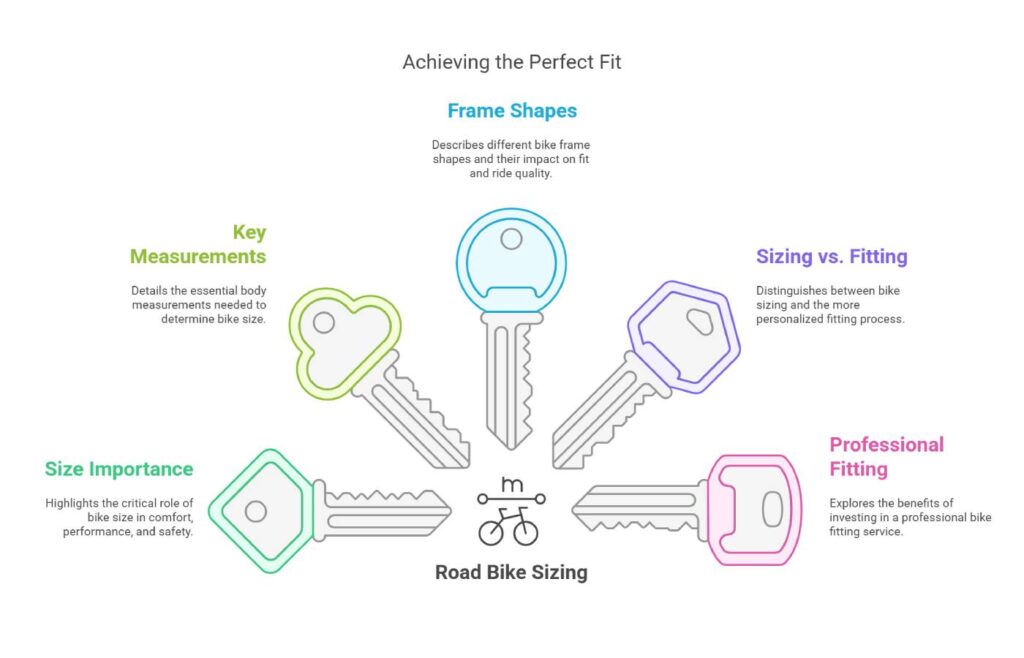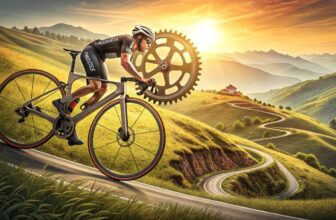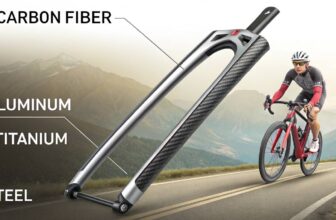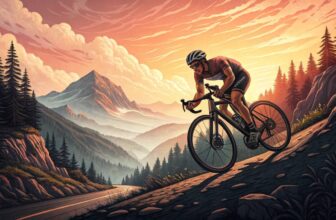Finding the perfect road bike size can transform your cycling experience from mediocre to magnificent. Imagine gliding effortlessly down your favorite routes, free from discomfort and fully harnessing your performance potential.
Whether you’re a seasoned racer or a weekend warrior, mastering bike sizing is essential for comfort, safety, and efficiency.
Dive into our comprehensive guide to discover expert tips and insights that ensure your road bike fits like a glove.

Say goodbye to awkward rides and hello to a seamless, enjoyable journey every time you hit the road!
Road Bike Sizing Guide
Why Getting the Right Size Matters
Getting the right size road bike is like finding a pair of shoes that fit just right—it’s all about comfort and performance. Picking a bike that fits your body ensures you ride smoothly, without feeling like a circus clown on an undersized unicycle or in danger of toppling over a too-tall frame.
A well-fitted bike is not only easier to handle, but it also reduces the odds of getting aches and pains in places you didn’t know had muscles.
When you’re scrolling online shops drooling over shiny bikes, most sizing advice is based on your height. But remember, we’re not all perfectly average, just like how finding jeans that actually fit can feel like winning the lottery. So, if you’re a bit outside the ordinary height and build, having someone measure you up the old-school way might be worth considering.
Most road bikes are sized in centimeters, which, in non-bike lingo, is like saying what notch your belt sits at. The key dimension is the seat tube length (The Bike Shoppe). Your inseam measurement is just as important—think of it as the gap between your saddle and the pedals, a number that directly affects how powerfully you can push those pedals down (Ridley’s Cycle).
| Rider’s Height | Bike Frame Size (cm) |
|---|---|
| 5’3″ – 5’6″ | 52 – 54 |
| 5’6″ – 5’9″ | 54 – 56 |
| 5’9″ – 6’0″ | 56 – 58 |
| 6’0″ – 6’3″ | 58 – 60 |
| 6’3″ – 6’6″ | 60 – 62 |
Bike Sizing vs. Bike Fitting: What’s the Deal?
Let’s get this straight: bike sizing and bike fitting aren’t the same thing, even if they sound like they should be. Bike sizing is the bit where you match the frame to your body size, kind of like picking the right t-shirt size.
Fitting, though—that’s all in the details, the stage where you tweak the bike’s main parts, from the height of your handlebars to the angle of your seat. It’s about molding your bike to suit you like your favorite hoodie.
This fitting business ranges from minor tweaks anyone could handle after a YouTube tutorial to full-on professional gigs that make you feel like you’re in a sci-fi movie with high-tech gadgets. For newbies to bike racing champs, it’s good sense to make your bike fit just right.
When eyeing up that new road bike, don’t just stop at the frame size. It’s about the full package experience. Getting your bike finely tuned to your unique needs transforms your riding from “Eh” to “Wow, let’s ride on forever!”
Curious about more ways to get your bike setup perfect? Peek at our guides on road cycling position and road bike pedals to get the lowdown.
Factors to Consider in Road Bike Sizing
Body Dimensions and Strength
Getting the right road bike is like finding a perfectly tailored suit—it’s all about fit. It starts with knowing your body dimensions and size. Think of it as the foundation for a comfy and high-performance ride.
- Height: This one’s pretty straightforward—most bike sizing charts go off your height to figure out the frame size.
- Inseam Length: This helps in deciding the right seat tube height, so your pedaling is smooth and efficient.
- Upper Body Dimensions: Your torso length and how far you can reach matter a lot in choosing a bike that won’t make you feel squished or stretched.
If you’re as strong as an ox, maybe opt for a bigger bike to match your power. But if you’re on the lighter side, a smaller frame might give you that nimble feel you want.
Mobility and Riding Goals
How bendy you are and what you plan to do with your bike play a huge role in picking the right size. Folks with yogi-like flexibility might like a racier frame, while those with less mobility could need something more upright for comfort.
Mobility
Mobility’s all about whether you can touch your toes or not because that’s going to affect the frame size you can handle:
- Flexibility Check: Flexy riders can go for a smaller frame for a sleek, race-ready position.
- Restriction Assessment: If flexibility isn’t your strong suit, you might need a bike that lets you sit more upright and chill.
Riding Goals
Knowing why you ride can help tweak your bike’s size. Not everyone bikes for the same reason, so your goals set the blueprint.
| Riding Goal | Recommended Setup |
|---|---|
| Competitive Racing | Smaller frame for speed and aerodynamics |
| Endurance Riding | Comfy setups with bigger frames |
| Commuting | Just-right size for easy-handling |
| Weekend Rides | Go for relaxed comfort |
| Triathlons | Built for race-day aerodynamics |
Whether you’re pedaling for fun, fitness, or speed, the right bike fit can change the game. While a pro fitting can nail down your size to a tee, if you’re just starting, online sizing guides are a good place to start. You can always get fitted more precisely later.
For more on how a bike’s geometry shapes your ride, check out our piece on road bike geometry. Getting your road bike size right means everything for feeling good, staying safe, and making the most of your ride. By thinking about body size, strength, flexibility, and what you want out of your riding, you’ll be well on your way to the perfect setup.
Different Frame Shapes for Road Bikes
Shopping for a road bike? Dive into the world of frame shapes: you’ve got traditional, semi-compact, and compact to pick from. Each frame shape impacts how the bike feels under you.
Traditional Frame Shape
Think of the traditional frame like meeting an old friend. It’s got that horizontal top tube making it look like a bike from back in the day—solid and sturdy. If you love a bike that rides with the stability your grandpa would nod at, this one’s calling your name.
| Frame Shape | Characteristics | Advantages | Disadvantages |
|---|---|---|---|
| Traditional | Horizontal top tube | Classic design & stable ride | Less standover clearance |
More wonky-weave on road bike geometry? Y’all can head over to our road bike geometry hub.
Semi-Compact Frame Shape
Semi-compact is the Goldilocks of bike frames—not too rigid, not too slanted, but just right. Got a slightly sloping top tube, making it a bit more modern but without losing touch with its roots. This one’s for those riders who want an easy balance between the tried-and-true feel and a brush of the new era.
| Frame Shape | Characteristics | Advantages | Disadvantages |
|---|---|---|---|
| Semi-Compact | Slightly sloping top tube | Better standover and balanced | Close call with traditional style |
If your heart’s torn between two styles, the semi-compact might just glue it back together.
Compact Frame Shape
The compact frame shouts ‘modern’ from the rooftops. It’s got this nifty sloping top tube with a shorter wheelbase, dialed down to maximize race day thrills. You’ll benefit from wicked standover clearance, but brace yourself—it’s built for speed, so long Sunday cruises might not be its jam.
| Frame Shape | Characteristics | Advantages | Disadvantages |
|---|---|---|---|
| Compact | Pronounced sloping top tube, shorter wheelbase | Better standover, stiffer vibe | Might not hug you right for long rides |
Perfect for the racers ready to eat up the competition like breakfast cereal.
Your choice of frame can shape every ride. Want more on bike geometry? Leap over to our road bike geometry quick-read. Before piecing together your bike masterpiece, explore insights about road bike brakes and road bike crankset types.
Choosing the Right Frame Size
Grabbing the right bike frame isn’t just a random game of guesswork, it’s a surefire way to keep your rides smooth and comfy. So, let’s roll through what you really need to know when picking out a road bike – seat tube length, seat tube equations, and those all-important stack and reach numbers.
Seat Tube Length vs. Nominal Seat Tube Length
You’re likely to hear big bike companies chatting about seat tube length a lot. But hang on–what’s the difference between good ol’ seat tube length and this fancy ‘nominal’ version? Well, the seat tube length is the straight-up distance from where the pedals hang to the seat post’s peak. The nominal seat tube length? It’s kind of a trickster, taking into account the slanty top tubes most modern bikes are using.
| Frame Type | Size Method | What in the World It Means |
|---|---|---|
| Road Bike (Traditional) | Seat Tube Length (cm) | Straight shot from the pedal anchor to the top of the seat tube |
| Road Bike (Compact) | Nominal Seat Tube Length | Factor in those fashionable slanty top tubes |
| Mountain Bike | Alpha Sizing (S, M, L) | Simple as Small, Medium, Large |
Stack and Reach Figures for Accurate Sizing
Now, if you wanna talk real precision, stack and reach have got you covered. These are the secret ingredients to figuring out how a bike cuddles up to your body shape and your riding swagger. They play a big part in making your bike cozy and buzzy on long hauls.
- Stack: It’s the up-down distance from where the pedals hang to the tip of the head tube.
- Reach: It’s the where-you-put-your-stuff distance from where your pedals rest to the same head tube tip.
Different Frame Geometries
- Traditional Frame Shape: All squared up with a flat top tube.
- Semi-Compact Frame Shape: A tad sloped, offering a mix between the old-school and the new-school.
- Compact Frame Shape: Slanted up top, with a shorter wheelbase for added nimbleness and stiffness underneath.
| Geometry Type | Stack (cm) | Reach (cm) | Ride Mood |
|---|---|---|---|
| Race Geometry | Lower | Longer | Fast and fierce |
| Endurance Geometry | Higher | Shorter | Laid-back and marathon steady |
These numbers give you a handy cheat sheet for comparing bikes from different brands. Getting the scoop on stack and reach helps you snag the right setup for how you plan to tackle the road. Wanna geek out even more on this stuff? Take a look at our article on road bike geometry.
So, when eyeing your next road masterpiece, check out frame size, stack, and reach like a hawk. Tack on some cherry-picked advice from our guides on road cycling position, as well as bits on road bike tire pressure and road bike maintenance to really seal the deal.
Assessing Standover Height
Determining Proper Standover Height
Standover height—it’s basically making sure you’re not too high off the ground or too up close and personal with your bike when you stop. To find the right fit, just stand over your bike’s top tube with both toes straight down. If you’re touching the top tube, you might wanna rethink that. You should have about a centimeter between your you-know-where and the tube (Thanks, BikeRadar).
For those classic bikes with straight top tubes—lookin’ like they’re trying to beam UFO signals—about an inch of space is the sweet spot. Got a bike with a top tube that slopes down like it’s trying to escape your handlebars? You’ll want a couple of inches of breathing room there. Whether you’re rocking a dude’s or a lady’s frame, compact is the name of the game (REI).
Here’s a handy table so you don’t have to break out the ruler:
| Bike Type | Clearance (inches) |
|---|---|
| Traditional Top Tube | 1″ |
| Sloping Top Tube | 2″+ |
Impact on Comfort and Safety
When it’s all about being comfy and not getting hurt, standover height is your best buddy. Getting it right means you can jump off that seat like a ninja and keep your balance when coming to a stop. It’s your bike’s way of giving you a safety parachute and a high-five wrapped up in one.
Miss that perfect height and it’s like wearing shoes on the wrong feet—awkward and risky, especially when dodging traffic or just trying not to make a scene. For more tips on making your ride smooth and safe, cruise through our articles on road bike geometry and road cycling safety.
But don’t stop there! Standover height is just the appetizer: reach, stack, and your riding position are the main course. Want the royal treatment? Go for a professional bike fit. They’ll check every angle of how you ride and make it suit your unique style and body. With the right fit, cycling turns into more of a joyride than a workout.
Road Bike Size Considerations
Getting the right road bike size is like finding Cinderella’s slipper; it has to fit just right for a smooth, enjoyable ride. Whether you’re new to the cycling game or a veteran, nailing the right size is crucial to having a blast while staying comfy, fast, and safe on the road. Let’s get the lowdown on how to pick the perfect size.
Online Sizing Recommendations
Buying a bike online? Don’t sweat it. Most sites offer sizing advice based on height and other vital stats. It’s a good jumping-off point, especially if you’re just dipping your toes into cycling. But don’t forget—everyone’s body is a little different. Your buddy’s ideal bike might not be what floats your boat.
Here’s a quick cheat sheet:
| Rider Height (ft/in) | Bike Size (cm) |
|---|---|
| 4’10” – 5’0″ | 47 – 48 cm |
| 5’0″ – 5’3″ | 49 – 50 cm |
| 5’3″ – 5’6″ | 51 – 53 cm |
| 5’6″ – 5’9″ | 54 – 55 cm |
| 5’9″ – 6’0″ | 56 – 58 cm |
| 6’0″ – 6’3″ | 58 – 60 cm |
| 6’3″ – 6’6″ | 61 – 63 cm |
These sizes consider things like seat tubes and top tube lengths. But if you’re more of a unique snowflake in terms of body build, don’t settle for a one-size-fits-all solution. Maybe a professional bike fit is your best bet for getting the perfect ride.
Opting for a Bike Fit for Precision
For those who want a bike perfectly molded like your favorite pair of sneakers, a professional bike fit is golden. Instead of guesstimating from charts, pros consider every inch of your body, how bendy you are, and what you plan to do—slick racing, smooth endurance rides, or daily commutes.
In a bike fitting, they’ll dive into:
- Body Dimensions: They’ll measure everything, from inseam to arm span—down to the inch.
- Mobility and Flexibility: Can you bend it like Beckham? They’ll check!
- Riding Style and Goals: Speed demon or casual cruiser? They got you.
Why get a pro fit? Because:
- Comfort: It’s like having cushioned seats all the way; keeps those aches away.
- Performance: Boosts your efficiency—more pedal, less hassle.
- Safety: Helps dodge injuries so you aren’t nursing a bad back from poor posture.
If biking is life, getting your ride fitted is a no-brainer. It’ll peak your comfort, boost your power, and make every trip as satisfying as a victory lap. Want to nerd out more? Check out stuff like different fork types and geek out on making your ride smoother.
By giving some of these pointers a whirl, you can inch closer to a bike that feels like it’s made just for you. For more stuff on keeping your bike in top shape and cycling safe and sound, dive into our maintenance and safety tips.
Gender-Specific Considerations
Unisex vs. Women-Specific Bikes
Trying to pick the right bike can feel like navigating a spaghetti junction, but there’s some help around the bend. Riders meet your options: unisex and women-specific bikes. Unisex road bikes cater to a variety of rider heights and body types. On the other hand, women-specific rides include some tweaks to fit the average female body better, like:
- Slimmer handlebars are perfect for generally narrower shoulders.
- Shorter top tubes to match shorter torsos are often found in ladies.
- Saddles are shaped for extra comfort and support.
So, what’s best for you? It’s all about personal comfort and fit, ’cause a good ride shouldn’t feel like wearing shoes two sizes too small.
Unique Geometry and Contact Points
So you want to feel like king or queen of the road – bike geometry’s your secret weapon. Think handlebars, saddles, and your riding stance, all playing a part in how you gel with your ride. There’s no one-size-fits-all in the bike world, but here’s the lowdown on what matters:
| Measurement | Description |
|---|---|
| Headtube Length | How high or low do your handlebars go? |
| Top Tube Length | Your stretch to the handlebars – not too far, not too close. |
| Chainstays | Balances your bike’s speediness and steadiness. |
| Wheelbase | Turns your wheels’ crazy dance into a smooth waltz. |
A bike that fits like a glove not only rides better but gives you comfort as you breeze past the finish line. And let’s not forget, that every bike maker has their twist on sizing. Dive into those custom size charts and maybe even hit up a profit service for adjustments, like tweaking the reach, stack, or chainstay length, to make riding feel effortless.
If you’re hungry for more tips on road bike sizing, poke around some more. There’s gold to find about your riding stance, gear tweaks, and how to keep your bike in check.
Bike Geometry and Sizing
Picking the perfect road bike ain’t just about color and style; it’s about how well it suits your riding. The bike’s design plays a big role in how you’ll fit on it and how it handles. You’ve got two major flavors: race and endurance. Plus, things, like reach, stack, and chainstay length, will totally change your vibe on the bike.
Race Geometry vs. Endurance Geometry
Race Geometry
Race geometry is all about that low and stretched-out posture you see with folks blasting down the road like they’re in the Tour de France. It’s your go-to for cutting through the wind and zooming along—spot on for racing pros who think comfort is for couches.
| Feature | Race Geometry |
|---|---|
| Riding Position | Low and Long |
| Primary Use | Kicking Competitors’ Butts |
| Comfort Level | Meh |
| Handling | Quick and Zippy |
Endurance Geometry
Now, if you’re the type that likes to sip a coffee between long rides, endurance geometry is your jam. You’ll sit a bit more upright, so your back doesn’t turn into a question mark. Perfect for those who appreciate cruising without their spine and neck hating them.
| Feature | Endurance Geometry |
|---|---|
| Riding Position | Comfy and Relaxed |
| Primary Use | Long, Enjoyable Rides |
| Comfort Level | Oh, so comfy |
| Handling | Calm and Collected |
For more insight on bike setup, check our extensive road bike geometry guide.
Reach, Stack, and Chainstay Length Effects
Get the lowdown on reach, stack, and chainstay length because they’re what make your bike the bike.
Reach and Stack Figures
- Reach: Imagine how far you gotta lean for those handlebars. Like leaning into a race car versus just stretching out on a comfy ride. Racers go long; cruisers go short.
- Stack: This is about how much bike meat is between the pedals and the head tube. Tall stack means you’ve got the view from a Cadillac; low stack means you’re in an F1 car.
| Geometry | Reach | Stack |
|---|---|---|
| Race Geometry | Far and Fast | Low Down |
| Endurance Geometry | Near and Neat | Sky High |
Folks who prefer comfort should look for a bike with a higher stack and shorter reach. Are those in a hurry? Go low stack and long reach. For the nitty-gritty details on bike positions, check road cycling position.
Chainstay Length
These length bits are what give your bike the personality. Short chainstays mean quicker turns and fun times; long ones offer stability, sort of like training wheels you won’t outgrow.
| Feature | Short Chainstay | Long Chainstay |
|---|---|---|
| Stability | Kind of Wobbly | Solid as a Rock |
| Responsiveness | Quick like Lightning | More Laid-back |
| Usage | Zipping Around Races | Comfortable Cruises |
Deciding on the right ride means knowing how these geometry tricks influence your feel and speed. Gear up for the type that suits your road shenanigans best. Peek into road bike sizing, and while you’re at it, check out nuggets on road bike maintenance and road bike tire pressure.
Conclusion
Choosing the right road bike size is more than just matching your height to a chart—it’s about understanding your body’s unique dimensions, strength, and riding goals.
From selecting the appropriate frame shape to considering factors like stack and reach, every detail contributes to a comfortable and efficient ride. Whether you’re eyeing a traditional frame for stability, a semi-compact for balance, or a compact frame for speed, the perfect fit can elevate your cycling experience.
Remember, a professional bike fit can fine-tune your setup, ensuring that every ride feels tailor-made just for you. Embrace the journey of finding your ideal bike size, and enjoy the seamless, safe, and exhilarating rides that follow.
Your perfect road bike awaits—ready to transform your cycling adventures into unforgettable experiences.
FAQs
What is the best way to determine my road bike size?
Start with your height and inseam measurements using a sizing chart, then consider a professional bike fitting for precise adjustments.
How does frame shape affect my ride?
Traditional, semi-compact, and compact frames offer different handling and comfort levels, tailored to various riding styles and preferences.
What is the difference between bike sizing and bike fitting?
Bike sizing selects the appropriate frame size based on body measurements, while bike fitting adjusts the bike’s components to fit your specific body and riding style.
Can I use online sizing guides if I’m outside the average height range?
Yes, but it’s recommended to get measured professionally to ensure the best fit tailored to your unique body dimensions.
Why is standover height important?
Proper standover height ensures safety and comfort by preventing you from being too high or too close to the bike frame when stopping.
Key Tips
- Measure Accurately: Use a tape measure for height and inseam length to ensure precise sizing.
- Consider Your Riding Style: Choose a frame shape that aligns with whether you prefer racing, endurance, or casual rides.
- Don’t Ignore Professional Fitting: A professional bike fit can fine-tune your setup for maximum comfort and performance.
- Check Standover Height: Ensure there’s adequate clearance to prevent discomfort and enhance safety.
- Adjust for Flexibility: Tailor your bike’s geometry to match your flexibility and riding goals.
Recommended Biking Products and Accessories
- Bike Fit Tools:
- Garmin Edge Bike Fit Kit
- Measuring Equipment:
- LeMond Tools Full Body Measurement Kit
- Comfort Enhancements:
- Selle Royal Respiro Gel Saddle
- Aerodynamic Cycling Gloves
- Performance Gear:
- Shimano Ultegra Groupset
- Specialized Power Meter Pedals
- Safety Accessories:
- Cateye Velo 8 Front/Rear Lights
- Bell Rally Reflective Helmet
- Maintenance Tools:
- Park Tool Cyclone Floor Drive Repair Stand
- Finish Line Complete Bike Tool Kit
- Cycling Apparel:
- Rapha Classic Cycling Jersey
- Pearl Izumi Pro Bike Shorts
- Hydration Solutions:
- CamelBak Podium Bike Hydration Pack
- Storage and Transport:
- Topeak Door-to-Door Bike Bag
- Technology Enhancements:
- Wahoo ELEMNT Bolt GPS Bike Computer
These products and accessories are selected to enhance your cycling experience, ensuring that your perfectly sized road bike is complemented with the best tools and gear available.




